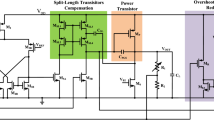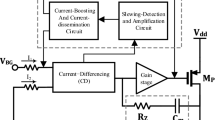Abstract
An output capacitor-less low-dropout (OCL-LDO) voltage regulator with dual active feedback paths is presented in this paper. The dual active feedbacks provide frequency compensation and spike voltage suppression. Two feedback loops are formed by capacitors Cc and Ca, respectively. The capacitor Ca path detects output voltage to suppress undershoot and overshoot during load transient. The frequency compensation is achieved by capacitor Cc, which helps the LDO regulator not only improve stability, but also enhance transient response without large current consumption. The total utilized capacitance values are only 1.5 pF. The proposed OCL-LDO was fabricated in 0.18 μm CMOS technology with supply voltage of 1.8 V. The LDO consumes 21 μA of quiescent current and the chip area is 0.47 mm × 0.49 mm. The measured output voltage difference is 90 mV when the load current is increased from 50 μA to 100 mA with CL= 100 pF and recovery time less than 1 μs. The power supply rejection is − 51.7 dB at 1 kHz.














Similar content being viewed by others
References
Rincon-Mora, G. A., & Allen, P. E. (1998). A low-voltage, low quiescent current, low drop-out regulator. IEEE Journal of Solid-State Circuits,33(1), 36–44.
Chava, C. K., & Siulva-Martinez, J. (2004). A frequency compensation scheme for LDO voltage regulators. IEEE Transactions on Circuits and Systems I: Regular Papers,51(6), 1041–1050.
Leung, K. N., & Mok, P. K. T. (2003). A capacitor-free CMOS low-dropout regulator with damping-factor-control frequency compensation. IEEE Journal of Solid-State Circuits,38(10), 1691–1702.
Lau, S. K., Mok, P. K. T., & Leung, K. N. (2007). A low-dropout regulator for SoC with Q-reduction. IEEE Journal of Solid-State Circuits,2(3), 658–664.
Man, T. Y., Mok, P. K. T., & Chan, M. (2007). A high slew-rate push-pull output amplifier for low-quiescent current low-dropout regulators with transient-response improvement. IEEE Transactions on Circuits and Systems II: Express Briefs,54(9), 755–759.
Milliken, R. J., Silva-Martinez, J., & Sánchez-Sinencio, E. (2007). Full-on chip CMOS low-dropout voltage regulator. IEEE Transactions on Circuits and Systems I: Regular Papers,54(9), 1879–1890.
Lam, Y. H., & Ki, W. H. (2008). A 0.9 V 0.35 m adaptively biased CMOS LDO regulator with fast transient response. In Proceedings of ISSCC Digest of Technical Papers (pp. 442–443).
Guo, J., & Leung, K. N. (2010). A 6-uW chip-area-efficient output-capacitorless LDO in 90-nm CMOS technology. IEEE Journal of Solid-State Circuits,45(9), 1896–1905.
Ho, E. N. Y., & Mok, P. K. T. (2010). A capacitor-less CMOS active feedback low-dropout regulator with slew-rate enhancement for portable on-chip application. IEEE Transactions on Circuits and Systems II: Express Briefs,57(2), 80–84.
Or, P. Y., & Leung, K. N. (2010). An output-capacitorless low-dropout regulator with direct voltage-spike detection. IEEE Journal of Solid-State Circuits,45(2), 458–466.
Zhan, C., & Ki, W. H. (2010). Output-capacitor-free adaptively biased low-dropout regulator for system-on-chips. IEEE Transactions on Circuits and Systems I,57(5), 1017–1028.
Zhan, C., & Ki, W. H. (2012). An output-capacitor-free adaptively biased low-dropout regulator with subthreshold undershoot-reduction for SoC. IEEE Transactions on Circuits and Systems I: Regular Papers,59(5), 1119–1131.
Ming, X., Li, Q., Zhou, Z.-K., & Zhang, B. (2012). An ultrafast adaptively biased capacitorless LDO with dynamic charging control. IEEE Transactions on Circuits and Systems II: Express Briefs,59(1), 40–44.
Chen, C.-M., Hung, T.-W., & Hung, C.-C. (2013). Fast transient low-dropout voltage regulator with hybrid dynamic biasing technique for SoC application. IEEE Transactions on Very Large Scale Integration (VLSI) Systems,21(9), 1742–1747.
Chong, S. S., & Chan, P. K. (2013). A 0.9-μA quiescent current output capacitorless LDO regulator with adaptive power transistors in 65-nm CMOS. IEEE Transactions on Circuits and Systems I: Regular Papers,60(4), 1072–1081.
Qu, X., Zhou, Z.-K., Zhang, B., & Li, Z.-J. (2013). An ultra-power fast transient capacitor free low-dropout regulator with assistant push–pull output stage. IEEE Transactions on Circuits and Systems II: Express Briefs,60(2), 96–100.
Chong, S., & Chan, P. (2014). A sub-1V transient-enhanced output-capacitorless LDO regulator with push-pull composite power transistor. IEEE Transactions on VLSI Systems,22(11), 2297–2306.
Zhan, C., & Ki, W.-H. (2014). Analysis and design of output-capacitor-free low-dropout regulators with low quiescent current and high power supply rejection. IEEE Transactions on Circuits and Systems I: Regular Papers,61(2), 625–636.
Park, C.-J., Onabajo, M., & Silva-Martinez, J. (2014). External capacitor-less low drop-out regulator with 25 dB superior power supply rejection in the 0.4–4 MHz range. IEEE Journal of Solid-State Circuits,49(2), 486–501.
Maity, A., & Patra, A. (2016). Tradeoffs aware design procedure for an adaptively biased capacitorless low dropout regulator using nested miller compensation. IEEE Transactions on Power Electronics,31(1), 369–380.
Maity, A., & Patra, A. (2016). Analysis, design and performance evaluation of a dynamically slew enhanced adaptively biased capacitor-less low dropout regulator. IEEE Transactions on Power Electronics,31(3), 2324–2336.
Hong, S. W., & Cho, G. H. (2016). High-gain wide bandwidth capacitor-less low dropout regulator (LDO) for mobile applications utilizing frequency response of multiple feedback loop. IEEE Transactions on Circuits and Systems I: Regular Papers,63(1), 46–57.
Torres, J., et al. (2014). Low drop-out voltage regulators: Capacitor-less architecture comparison. IEEE Circuits and Systems Magazine,14(2), 6–26.
Hazucha, P., Karnik, T., Bradley, B. A., Parsons, C., Finan, D., & Borkar, S. (2005). Area-efficient linear regulator with ultra-fast load regulation. IEEE Journal of Solid-State Circuits,40(4), 933–940.
Acknowledgements
The authors would like to thank National Chip Implementation Center (CIC), Taiwan for their support on chip fabrication. This work was supported by Ministry of Science and Technology (MOST).
Author information
Authors and Affiliations
Corresponding author
Additional information
Publisher's Note
Springer Nature remains neutral with regard to jurisdictional claims in published maps and institutional affiliations.
Rights and permissions
About this article
Cite this article
Su, CC., Hung, CC. Dual active capacitive feedbacks for output capacitor-less low-dropout regulator. Analog Integr Circ Sig Process 101, 573–584 (2019). https://doi.org/10.1007/s10470-019-01500-3
Received:
Revised:
Accepted:
Published:
Issue Date:
DOI: https://doi.org/10.1007/s10470-019-01500-3




